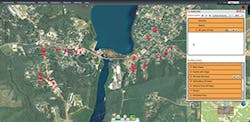When looking at the features of an AMI system, utilities should consider the benefits of pressure management analytics, says Joe Ball, director of water solutions marketing for Itron, Liberty Lake, WA. “A pressure management system can be helpful because some utilities have an issue with pressure zones,” explains Ball. “It’s tough to maintain a perfect pressure when there could be issues such as elevation and demand on the network. So the pressure has to be monitored throughout the day. But some utilities end up running the pressure at a higher rate, and it’s very hard on the network infrastructure, especially if there are leaks and cracks. The pressure fluctuates throughout the day and it puts a lot of strain on the network. And it increases the potential for larger leaks.”
When looking at the features of an AMI system, utilities should consider the benefits of pressure management analytics, says Joe Ball, director of water solutions marketing for Itron, Liberty Lake, WA. “A pressure management system can be helpful because some utilities have an issue with pressure zones,” explains Ball. “It’s tough to maintain a perfect pressure when there could be issues such as elevation and demand on the network. So the pressure has to be monitored throughout the day. But some utilities end up running the pressure at a higher rate, and it’s very hard on the network infrastructure, especially if there are leaks and cracks. The pressure fluctuates throughout the day and it puts a lot of strain on the network. And it increases the potential for larger leaks.” [text_ad] Itron’s system allows for pressure monitors and sensors at multiple sites in a pressure zone, and features a control mechanism that analyzes existing pressure and adjusts the controls to optimize the pressure throughout the day. Ball adds, “In the past, you had to send a workman out to take a pressure reading. But today you can utilize sensors to tell you the pressures from the AMI network, and you get much more frequent data in a granular format. So instead of just saying we need a certain pressure for that critical zone, the analytics can tell you that you don’t have to keep it that high. It monitors pressure fluctuations and helps save the infrastructure.” With Itron’s analytic solution, a utility can group all of the customers in a district into a pressure zone and compare the consumption at their meters, with the amount of water running through the district meter. Acoustic leak sensor data can be added, so if there’s a district that has a variance, the additional data can pinpoint potential distribution leaks in that particular district. The results of the comparison is to identify leaks and the volume of lost water, so the utility can prioritize their maintenance strategy. [text_ad use_post='27751'] Depending on the size of the utility’s service area, setting up an AMI system with all the features of leak detection and pressure zone reading could appear fairly daunting, but it can be done in manageable steps. “You can do it during the AMI install with just a port on the communication module because it will identify the leak sensors and start recording the acoustics every 22 1/2 minutes, and it sends that data to the software,” says Ball. “It’s very powerful, especially for utilities such as those in California where all the restrictions and mandatory reductions have been put in place and both distribution and meter leaks are a way to grab some low hanging fruit.”Itron’s system allows for pressure monitors and sensors at multiple sites in a pressure zone, and features a control mechanism that analyzes existing pressure and adjusts the controls to optimize the pressure throughout the day. Ball adds, “In the past, you had to send a workman out to take a pressure reading. But today you can utilize sensors to tell you the pressures from the AMI network, and you get much more frequent data in a granular format. So instead of just saying we need a certain pressure for that critical zone, the analytics can tell you that you don’t have to keep it that high. It monitors pressure fluctuations and helps save the infrastructure.”
With Itron’s analytic solution, a utility can group all of the customers in a district into a pressure zone and compare the consumption at their meters, with the amount of water running through the district meter. Acoustic leak sensor data can be added, so if there’s a district that has a variance, the additional data can pinpoint potential distribution leaks in that particular district. The results of the comparison is to identify leaks and the volume of lost water, so the utility can prioritize their maintenance strategy.

